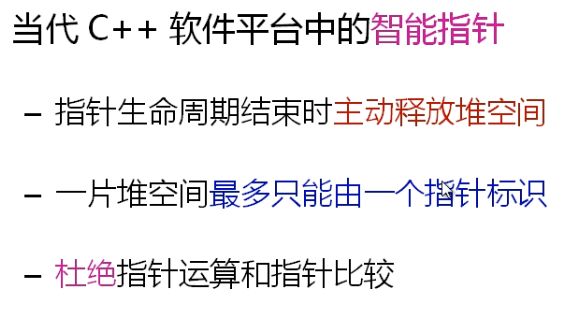智能指针在开发中无处不在,智能指针就是用C++模板技术实现的一个类。
智能指针历史:为了解决内存泄漏

使用智能指针:

智能指针的设计方案:
通过类模板描述指针的行为
能够定义不同类型的指针对象
重载指针特征操作符(->和*)
利用对象模拟原生指针的行为
对象在生命周期结束的时候会调用析构函数,然后在析构函数中主动的释放堆空间
C++原生语言里面不存在智能指针,我们需要自己创建智能指针。
下面我们开始正式的编写可复用库的程序,开发环境为Qt creator,首先给出智能指针的程序如下:
1 #ifndef SMARTPOINTER_H 2 #define SMARTPOINTER_H 3 4 namespace DTLib 5 { 6 7 template <typename T> 8 class SmartPointer 9 { 10 protected: 11 T *m_pointer; 12 13 public: 14 SmartPointer(T *p = NULL) 15 { 16 m_pointer = p; 17 } 18 19 SmartPointer(const SmartPointer<T>& obj) 20 { 21 m_pointer = obj.m_pointer; 22 23 const_cast<SmartPointer<T>&>(obj).m_pointer = NULL; 24 } 25 26 SmartPointer<T>& operator= (const SmartPointer<T>& obj) 27 { 28 if(this != &obj) 29 { 30 delete m_pointer; 31 32 m_pointer = obj.m_pointer; 33 34 const_cast<SmartPointer<T>&>(obj).m_pointer = NULL; 35 } 36 37 return *this; 38 } 39 40 T* operator-> () 41 { 42 return m_pointer; 43 } 44 45 T& operator* () 46 { 47 return *m_pointer; 48 } 49 50 bool isNull() 51 { 52 return (m_pointer == NULL); 53 } 54 55 T* get() 56 { 57 return m_pointer; 58 } 59 60 ~SmartPointer() 61 { 62 delete m_pointer; 63 } 64 }; 65 66 } 67 68 #endif // SMARTPOINTER_H
测试程序的主函数如下:
1 #include <iostream> 2 #include <SmartPointer.h> 3 using namespace std; 4 using namespace DTLib; 5 6 class Test 7 { 8 public: 9 Test() 10 { 11 cout << "Test()" << endl; 12 } 13 14 ~Test() 15 { 16 cout << "~Test()" << endl; 17 } 18 }; 19 20 int main() 21 { 22 SmartPointer<Test> sp = new Test(); 23 return 0; 24 }
执行结果如下:

可见,我们定义了一个智能指针变量,程序执行时自动执行了构造函数,结束时触发了析构函数。
更改主函数,再次测试:
1 #include <iostream> 2 #include <SmartPointer.h> 3 using namespace std; 4 using namespace DTLib; 5 6 class Test 7 { 8 public: 9 Test() 10 { 11 cout << "Test()" << endl; 12 } 13 14 ~Test() 15 { 16 cout << "~Test()" << endl; 17 } 18 }; 19 20 int main() 21 { 22 SmartPointer<Test> sp = new Test(); 23 24 SmartPointer<Test> nsp; 25 26 nsp = sp; 27 28 cout << sp.isNull() << endl; 29 cout << nsp.isNull() << endl; 30 31 return 0; 32 }
结果如下:

可以看到,一片空间只能有一个指针标识。
再次更改主函数测试程序:
int main() { SmartPointer<Test> sp = new Test(); SmartPointer<Test> nsp; nsp = sp; nsp++; cout << sp.isNull() << endl; cout << nsp.isNull() << endl; return 0; }
编译结果如下:

可见,指针不能进行运算。
从以上测试程序得到的结果可以看出,我们的智能指针满足了前文提到的三条要求。
智能指针的使用军规:
只能用来指向堆空间中的单个对象或者变量。
不能用来指向堆空间中的数组。
不能指向局部的对象或者局部变量。
小结:
指针特征操作符(->和*)可以被重载
重载指针特征符能够使用对象代替指针
智能指针只能用于指向堆空间中的内存
智能指针的意义在于最大程度的避免内存问题